Volume 31, Issue 3, Summer 2023
Bart Pickelman, MIOSHA Director

As we kick off summer, it's imperative to remember workers face a growing number of potential hazards. Employers and employees need to watch out for more than just hot weather during the summer. In May, a 70-year-old traffic flagger was fatally hit by a car while regulating traffic at a road construction project.
Safety Efforts
As construction season ramps up, it's important to remember excavation and trenching continue to be some of the most dangerous construction activities.
MIOSHA recently took part in the National Utility Contractors Association Trench Safety Stand Down Week (June 19-23,2023). At safety stand down events, MIOSHA met with employers to encourage them to talk directly with their workers about hazard recognition and how to implement safety measures when working in a trench.
From August 7-11, 2023, (MIOSHA) will partner with employers to "Take a Stand" for workplace safety and health by dedicating our professional staff to visit Michigan high-hazard industries targeted by the MIOSHA. There will be NO citations or fines for participating workplaces. However, participants must agree to correct all serious conditions.
Heat Illness
Recognizing heat and humidity as hazards and planning for them is important since an average of 32 employees nationwide die annually from heat-related injuries, according to the U.S. Bureau of Labor Statistics (BLS). Many of these fatalities are new or temporary workers who have not been properly acclimated to working in hot and humid conditions.
Federal OSHA is in the process of developing a heat standard to protect indoor and outdoor workers which MIOSHA will be required to adopt. In the meantime, our agency has developed a sample heat illness prevention plan that employers can use as a template to establish their own heat illness prevention procedures and reduce the risk of work-related heat illness among their employees.
Employers and employees are encouraged to review the Heat-Related Illness - State Emphasis Program for consultative assistance and MIOSHA’s enforcement policy regarding heat hazards.
|
 |
William Matte, Service Manager, Cintas Corporation- D26-Troy, MI
The Cintas Corporation is widely recognized as one of the work leaders in health and safety performance. This is one on our three bullets in our safety vision.
Cintas takes pride in one of our best practices regarding safety, submitting safety leads.
Every employee at Cintas participates in our safety lead program. That consists of everyone submitting leads that can help everyone stay safe in their day-to-day jobs. These leads can be safety incidents, close calls, or even best practices that we see out at customers, on the road, or at our homes in our personal lives.
We go over submitted leads in our one-on-one check-ins, service meetings, and location meeting. The goal of this is to have a raise awareness for safety hazards in the field and we brainstorm ways to stay safe and go home the same way we came to work.
Our safety pyramid sums up the importance of submitting leads and staying safe. In short, if we minimize the number of unsafe behaviors, we are saving a life.
Safety Leads
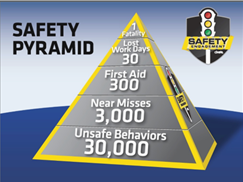
Important elements of the Cintas Safety Program are the Safety Leads and incident reporting
- Safety leads are hazard, near misses, or even best practices that are brought by the partners to their manager.
- Cintas believes that if unsafe conditions and incidents are reported quickly, action can be taken to prevent similar incidents from occurring in the future.
-
The Safety Pyramid (above): The safety triangle, also known as safety pyramid, is a theory of industrial accident prevention. It seeks to develop links between fatal accidents, minor accidents, and near misses.
- If you see any unsafe conditions or are involved in an incident of ANY kind, report it immediately.
- Reporting methods include alerting your manager via paper form or cell phone app.
|
By Eric Allen, Health and Safety Manager, Construction Safety and Health Division

During a March 2018 inspection of a building undergoing interior renovations, a MIOSHA Safety Representative (WSR) spotted a group of municipal workers exiting a parking lot excavation site.
The 8-foot deep excavation, was approximately 15 feet long and 13 feet wide, and was not associated with the renovation of the multi-employer worksite. No shoring or sloping methods were utilized, and no dewatering equipment was present. The WSR identified the excavation as an imminent danger situation and requested workers stay away until protective measures were put in place. After an inspection was opened, the WSR determined the municipal workers were attempting to replace a faulty water main valve that serviced a nearby retail store and movie theater.
During the MIOSHA inspection, representatives from both businesses came to the jobsite to inquire about the anticipated timeframe of the water restoration. Eventually, a trench box was brought to the jobsite by the employer and lowered into the excavation. The workers descended the ladder into the excavation and repaired the water main faulty valve while inside the trench box.
|
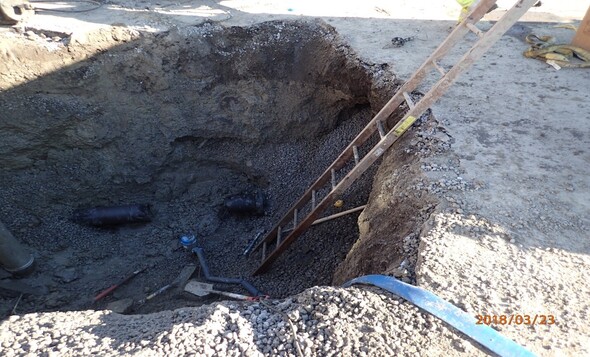 On March 23, 2018, a MIOSHA Construction Workplace Safety Representative (WSR) spotted municipial workers fixing a water line main break without using proper sloping and shoring methods
Regulatory violations identified
The violations alleged against the municipality were as follows:
-
Part 1. General Rules
- Rule 408.40114(1). An employer shall develop, maintain, and coordinate with employees an accident prevention program, a copy of which shall be available at the worksite.
-
Part 6. Personal Protective Equipment
- Rule 1926.100(a) Employees working in areas where there is a possible danger of head injury from impact, or from falling or flying objects, or from electrical shock and burns, shall be protected by protective helmets.
- Rule 1926.102(a)(1) The employer shall ensure that each affected employee uses appropriate eye or face protection when exposed to eye or face hazards from flying particles, molten metal, liquid chemicals, acids or caustic liquids, chemical gases or vapors, or potentially injurious light radiation.
Table 1: Maximum Allowable Angle of Repose for the Side of an Excavation in Excess of 5' Depth
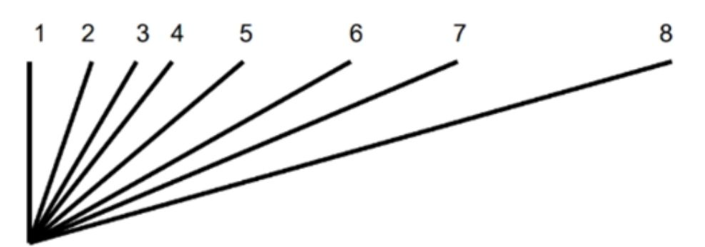
MIOSHA encourages all employers to be aware of the danger excavations can pose. To bring awareness to these hazards, MIOSHA held an Excavation and Trenching Panel Discussion on April 13. The video from the panel discussion was uploaded to MIOSHA’s YouTube page.
Additionally, MIOSHA's website provides information for employers and employees on working safely during excavation activities. The week of June 19-23, 2023, National Utility Contractors Association (NUCA) hosts a national Trench Safety Stand Down that is supported by Federal OSHA. MIOSHA held several Stand Down events with participating contractors during the week-long Trench Safety Stand Down.
The MIOSHA Consultation Education and Training (CET) Division offers free, statewide safety and health assistance to employers and employees. Our in-house team of experienced, professional occupational safety experts, construction safety consultants and industrial hygienists provides a wide range of customized services for management and staff.
Check out our full list of services to learn how you can request free consultative visits with no citations or penalties, receive awards and recognition, apply for grant funding and more. MIOSHA CET can be reached at: 517-284-7720.
By James Kassuba, Workplace Safety Representative, General Industry Safety and Health Division
An automotive component manufacturing company is facing dozens of alleged serious and repeat safety violations that endangered employees.
MIOSHA identified 33 regulatory violations during two safety inspections at the company's 800-person facility in August 2022. The first inspection was a comprehensive safety inspection with the site selected at random. The second inspection was opened when MIOSHA received an employer-reported referral of a fingertip amputation. The facility assembles and markets automotive products with operations ranging from welding and fabrication to warehousing and storage.
The number of citations are listed below. Some violations were grouped into single citations:
- 11 Serious
- 5 Repeat Serious
- 7 Other-Than-Serious
- 2 Repeat Other-Than-Serious
Citation breakdown:
Act 154. Michigan Occupational Safety and Health Act, Act 154 of 1974
- Section 11(a): There were no protective barriers or guarding on the carbon dioxide Class IV welding laser, no Laser Safety Officer onsite to monitor the operation, and no use of filtered eye or face protection for operators. Operators were not adequately trained on the hazards of lasers, the use of safety devices, and procedures to safely operate laser equipment.
Part 1. General Provisions
- Rule 408.10011(c): Compressed gas cylinders were not restrained.
- Rule 408.10015(1): A pallet of metal parts was inadequately stacked on the second tier of industrial racking (see photo below).
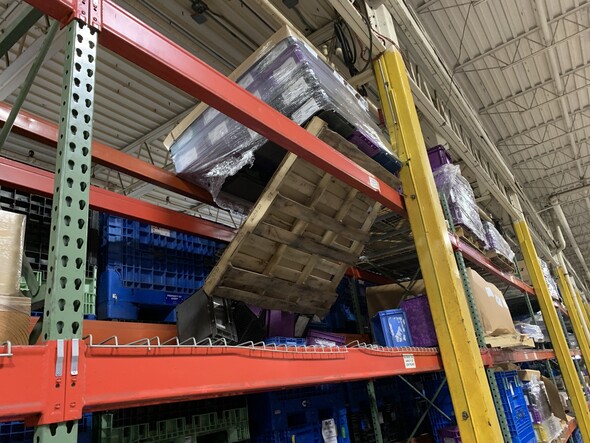
- Rule 408.10033(2): Foot-activated control devices were inadequately guarded against accidental actuation (see photo below).
- Rule 408.10034(9): No guard on a non-point-of-operation pinch point.
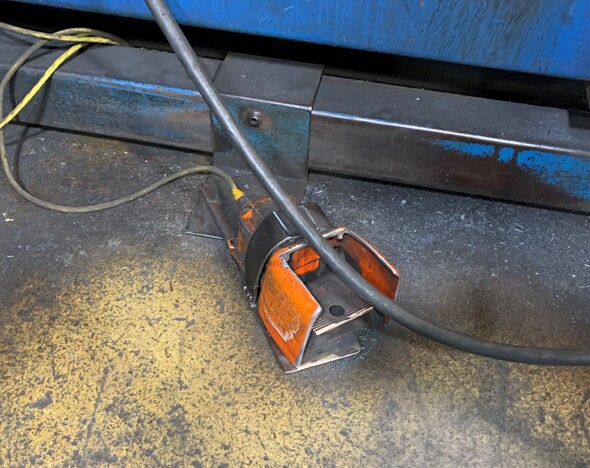 Part 1A. Abrasive Wheels
- Rule 408.10187(1): Excessive opening between the periphery and abrasive wheel on a pedestal grinder.
Part 2. Walking-Working Surfaces
Paragraph 22(a)(3): Pooled water created a slip hazard in a walkway.
- Paragraph 1910.22(a)(3): Pooled water created a slip hazard in a walkway.
- Paragraph 1910.22(d)(1): Stairwell had damaged steps (see photo below).
- Paragraph 1910.28(b)(3)(iv): No self-closing gates or offsets for ladderways.
- Paragraph 1910.29(b)(3): Inadequate top rail on a guardrail.
 GI Part 6. Fire Exits
- Rule 408.10632(1): Blocked emergency exit routes.
GI Part 11. Polishing, Buffing, and Abrading
- Rule 408.11115(4): Missing guards on belt sander nip points.
GI Part 12. Welding and Cutting
- Rule 408.11211(1)(d): Adequate protective devices (curtains) were not provided to reduce the risk of flash burns from welding.
- Rule 408.11212(6): Compressed gas cylinder was left in the open position.
- Rule 408.11223(1): Compressed gas cylinders used for welding were not restrained.
- Rule 408.11275(2): TIG welder was left unattended and not turned off.
- Rule 408.11281(5): Damaged electrical disconnect switch on a resistance welder.
GI Part 18. Overhead and Gantry Cranes
- Rule 408.11861(6): Unattended loads on overhead cranes were not landed.
GI Part 21. Powered Industrial Trucks
- Rule 408.12154(1): Employees were not provided training and permitting to operate forklift trucks.
GI Part 26. Metalworking Machinery
- Rule 408.12611(a): Employees were not provided training on the hazards and safe operations for unjamming metalworking machinery.
- Rule 408.12618(1): Energy control procedures were not utilized when an employee unjammed metalworking machinery.
- Rule 408.12635(1)(b): Employees did not adjust the blade guard within ¼-inch of the stock while operating the bandsaw (see photo below).
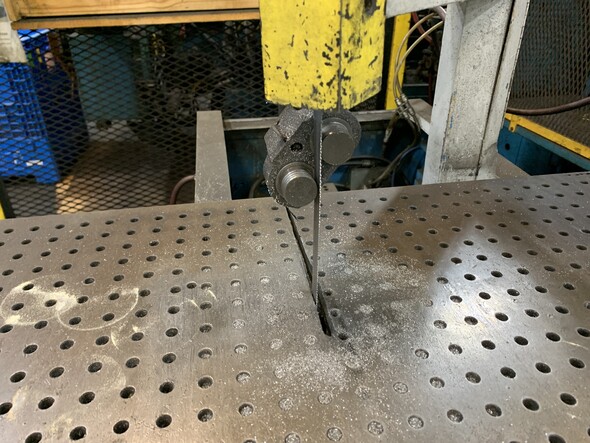 GI Part 33. Personal Protective Equipment
- Rule 408.13312(1): Employees did not utilize appropriate eye and face protection for laser exposure.
GI Part 39. Design Safety Standards for Electrical Systems
- Paragraph 1910.303(g)(1): Blocked access to electrical equipment.
- Paragraph 1910.303(g)(2)(i): Exposed electrical conductors.
- Paragraph 1910.334(a)(2)(ii): Missing ground pole on a power cord.
- Paragraph 1910.305(c)(4): Missing cover on a light switch.
- Paragraph 1910.305(g)(1)(iv): A flex cord was used in lieu of fixed wiring for a pedestal grinder.
GI Part 40. Safety-Related Work Practices
- Paragraph 1910.333(b)(2): Energy control procedures were not utilized when performing electric-related service.
GI Part 49. Slings
- Rule 408.14965(1): Damaged synthetic web slings were not removed from service.
GI Part 85. The Control of Hazardous Energy Sources
- Paragraph 1910.147(c)(4)(i): Energy control procedures were not utilized while performing service and maintenance-related tasks.
- Paragraph 1910.147(c)(4)(ii): The machine-specific lockout procedure did not cover all the steps involved in lockout.
- Paragraph 1910.147(f)(3)(ii)(D): Group lockout was not utilized when employees were performing repairs to machinery.
The cited company belongs to industrial sector called Transportation Equipment Manufacturing (North American Industry Classification System code 336). NAICS 336 is one of eight high-hazard industries targeted by MIOSHA in its 2019–2023 strategic plan for reductions in injury and illness rates. With Michigan’s leading role in the automotive industry, NAICS 336 is the largest high-hazard industry in the state, employing 179,000 workers and accounting for approximately 30 percent of all manufacturing jobs in Michigan. Individuals employed in this sector can be exposed to a wide range of safety and health hazards.
If you are interested in the MIOSHA standards and publications related to the hazards found in Transportation Equipment Manufacturing or any other industry, you can locate the information on the MIOSHA website. In addition, MIOSHA's Consultation Education and Training (CET) Division provides onsite consultation, hazard surveys, and training at little to no cost to employers. For free safety and health consultative assistance from MIOSHA CET, please complete the request online.
By Mike Krafcik, MIOSHA Communications Specialist
MIOSHA Renews Alliances with Several Organizations
University of Michigan, Center for Occupational Health and Safety Engineering (COSHE)
MIOSHA was pleased to renew its alliance agreement with the University of Michigan Center for Occupational Health and Safety Engineering on June 14. The purpose of the alliance is to promote workplace safety and health by leveraging the resources of MIOSHA and U of M (COHSE). The alliance will promote dialogue, develop resources, promote access to training, and share information with Michigan workers and employers.
Associated General Contractors of Michigan (AGC)
MIOSHA was pleased to renew its alliance agreement with AGC on May 23. The agency and the association began working closely together towards forming an alliance in 1998, to increase worker awareness and safety and health protection on AGC member worksites. In 2002, Federal OSHA established the alliance program to develop voluntary, collaborative, working relationships with organizations that are committed to workplace safety and health. States operating their own programs for occupational safety and health, were encouraged to adopt a similar program. On December 22, 2003, MIOSHA created Agency Instruction MIOSHA-ADM-03-3 Establishment of MIOSHA Alliances. This instruction provides MIOSHA policy and procedures for the development and approval of individual alliances and for the operation and management of overall alliance activity. AGC of Michigan has been a MIOSHA Alliance partner since the inception of MIOSHA’s formal alliance program.
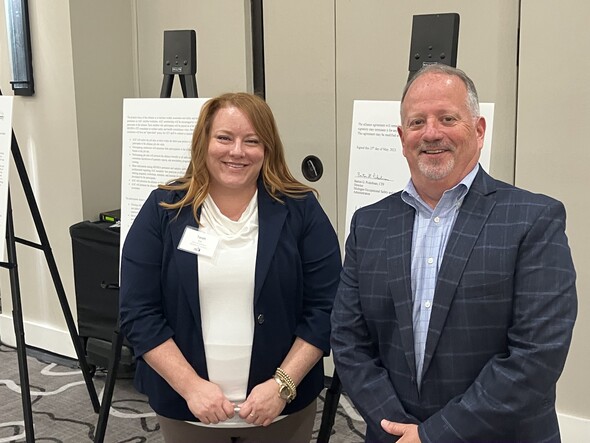 MIOSHA Consultation, Education and Training Division Director Tarah Kile is pictured with AGC Michigan President Damian Hill at the MIOSHA/AGC Michigan Alliance renewal signing May 25.
Operating Engineers Local 324 Journeyman & Apprentice Training Fund, Inc. (OE 324 JATF & stationary)
MIOSHA and Operating Engineers Local 324 Journeyman & Apprentice Training Fund Inc., renewed its Alliance agreement on April 12. A celebratory signing ceremony is planned for July 12. The alliance provides 14,000 OE JATF members and others with information, guidance, and access to training resources that will help them protect the health and safety of workers, particularly by reducing and preventing exposure to Mobile Equipment, Excavation, and Crane Operation hazards.
The MIOSHA Alliance Program is open to all groups, including trade or professional organizations, government agencies, businesses, labor organizations and educational institutions. With a three-year written agreement with MIOSHA, your organization can formalize the opportunity to collaborate on outreach and education and lead Michigan’s employers and employees in advancing workplace safety and health. Build a trusting, cooperative relationship with us, network with like-minded safety professionals and leverage resources to maximize workplace safety and health today. Learn more by visiting the Michigan Alliances section of the MIOSHA website.

Eaton Steel Bar Company Becomes an MSHARP Site
A pair of Eaton Steel Corporation plants became the latest Michigan Safety and Health Achievement Recognition Program (MSHARP) sites approved by MIOSHA.
Based in Taylor, Eaton Steel Bar Company received MSHARP approval effective June 14. The metal merchant wholesaler facility was recognized for its state-of-the-art camera system used to analyze all safety incidents and accidents. An MSHARP recognition exemplifies the result of successful efforts by employees, management, and government in partnering for excellence in workplace safety and health.
In a separate MSHARP award approval, Eaton Steel's Oak Park facility was approved as a MSHARP site on May 17. The 153-employee steel bar cutting, processing and warehousing facility maintained an exceptional job at promoting the importance of ergonomics in the workplace. The company has a written safety policy and program, and encourages participation in daily paid ergonomic exercise and provides an on-site workout room with access to personal trainers.
Eaton Steel is commended for demonstrating that a company culture that promotes management commitment, employee involvement, and a desire to excel in safety and health, not only reduces injuries and illnesses in the workplace, but can also be a positive experience in promoting safety and health for all.
The MSHARP program is open to employers with 250 employees or less and injury and illness rates below the Michigan average in their NAICS code over the last year.
|
 |
By Shannon Matsumoto, Manager, MIOSHA FOIA Section/Technical Services Division
MIOSHA General Industry Part 73, Fire Brigades
MIOSHA held a public hearing June 14, 2023, on General Industry Standard Part 73: Fire Brigades. The current rules are being revised to adopt by reference National Fire Protection Association (NFPA) standard 1971 Standard on Protective Ensembles for Structural Fire Fighting and Proximity, 2007 and 2013 editions.
Due to other legislation, the Michigan Occupational Safety and Health Act, Act 154 of 1974 was amended to require the director of the Department of Labor and Economic Opportunity to promulgate rules regarding a firefighter’s use of firefighting foam concentrate containing a perfluoroalkyl or polyfluoroalkyl substance (PFAS).
Stay tuned for final versions to be added to the MIOSHA standards web page once they are approved.
Quick Links
Agency/Division Instructions/Memorandums
Air Contaminants Initiative
Asbestos Program
CET Request for Consultative Assistance Services (RCA)
CET Training Calendar
Construction Safety and Health Division (CSHD)
DVD/Video Library Service
Employee Safety, Health, and Discrimination Complaint Forms
Fall Prevention Campaign (STOP FALLS. SAVE LIVES.)
General Industry Safety and Health Division (GISHD)
Hazard Communication/GHS
Laboratory and Equipment Services
Michigan Alliances Michigan Safety and Health Achievement Recognition Program (MSHARP)
Michigan Voluntary Protection Program (MVPP)
MIOSHA FOIA Request
MIOSHA News
MIOSHA Publications
MIOSHA Recordkeeping
MIOSHA Standards
MIOSHA Training Institute (MTI)
MIOSHA Updates
MIOSHA Variances
Radiation Safety Section
Residential Construction
Strategic Plan and Initiatives
Telephone, Mailing and Email Addresses
|